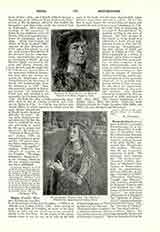

Pinturicchio (BERNARDINO DI BETTO, surnamed PINTURICCIJIO), b. at Verona, about 1454; d. at Siena, December 11, 1513. He studied under Fiorenzo di Lorenzo; and his fellow students, perhaps because of his great facility, surnamed him Pinturicchio (the dauber). Pinturicchio did an immense amount of work. His principal easel pictures are: “St. Catherine” (National Gallery, London); a “Madonna” (Cathedral of Sanseverino), with the prothonotary, Liberato Bartello, kneeling; “Portrait of a Child” (Dresden Gallery); “Apollo and Marsyas” (the Louvre), attributed to Perugino, Francia, and even Raphael; the “Madonna enthroned between saints”, an altar-piece (Pinacotheca of Perugia); the “Madonna of Monteoliveto” (communal palace of an Gimignano); a “Coronation of the Virgin l l (Pinacotheca of the Vatican); the “Return of Ulysses” (National Gallery, London); the “Ascent of Calvary”., a splendid miniature (Borromeo Palace, Milan). Ile was chiefly a frescoist, following principally the process of distemper (tempera). There are frescoes of his in the Sistine Chapel, in the decoration of which he assisted Perugino in 1480, Ara Coeli, the Appartamento Borgia, Spello, Siena, and Sta Maria del Popolo. Modern critics agree in recognizing as his two frescoes in the Sistine Chapel, the “Baptism of Jesus” and “Moses journeying to Egypt“. The Bufalini commissioned him to paint the life of St. Bernardine for the chapel at the Ara Coeli; but his chief work was the decoration of the Borgia apartment entrusted to him by Alexander VI. His compositions begin in the Hall of Mysteries, so called because it contains the “Annunciation”, the “Visitation”, the “Crib“, the “Resurrection“, the “Pentecost”, the “Ascension“; that of the “Resurrection” contains a splendid portrait of Alexander VI. In the Hall of Saints, the most beautiful of all, he has outlined with much grace and brilliancy the histories of various martyrs: St. Susanna, St. Barbara, Disputation of St. Catherine, Visit of St. Anthony to St. Paul the Hermit, and the Martyrdom of St. Sebastian. The next hall is devoted to. the representation of the Liberal Arts. Critics generally deny that the decoration of the last two rooms is the work of Pinturicchio, but the three large rooms which he certainly decorated form an exquisite museum. Following the Sienese school Pinturicchio enlivened his paintings by making use of sculptured reliefs glistening with gold which he mixed with his frescoes. In 1501 he decorated the chapel of the Blessed Sacrament in St. Mary Major at Spello. On the ceiling he painted four Sibyls and on the walls the Annunciation, the Adoration of the Shepherds and the Arrival of the Magi, and Jesus in the midst of the Doctors. He had a special love for these pictures for in them he placed his own portrait. In 1502 Cardinal Francisco Piccolomini commissioned him to depict the life of his uncle, Pius II, in ten large compositions on the side walls of the Piccolomini library at Siena. These frescoes are fifteenth-century tableaux vivants in which people of all conditions are represented. Above the altar erected at the entrance to the Library is seen the Coronation of Pius III. Pinturicchio, again summoned to Rome by Julius II, painted on the ceiling of the choir of Sta Maria del Popolo splendid Sibyls and Doctors of the Church, in stucco frames separated by graceful arabesques.
GASTON SORTAIS

